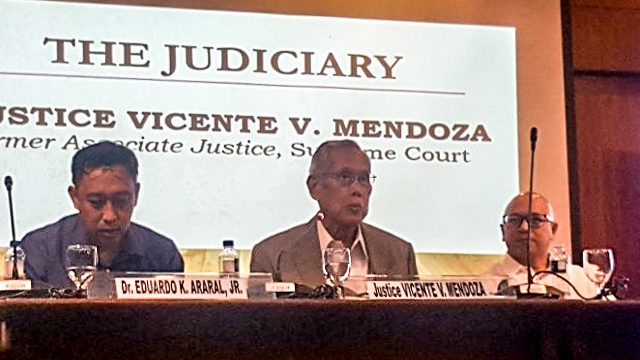SUMMARY
This is AI generated summarization, which may have errors. For context, always refer to the full article.

MANILA, Philippines – The creation of 3 high courts aside from a Federal Supreme Court wil lead to the “impoverishment of the judicial process,” said former Supreme Court associate justice Vicente Mendoza.
Mendoza was speaking at a forum about the Consultative Committee’s draft federal constitution on Thursday, August 1 in Quezon City.
The Duterte-formed Con-Com proposed in its draft to create 4 high courts under a federal Philippines – a Federal Supreme Court, Federal Constitutional Court, Federal Administrative Court, and Federal Electoral Court.
Mendoza argued that the creation of multiple courts will lessen the prestige of the Supreme Court, thereby compromising the ability of the judicial branch to hold the other two branches accountable.
The creation specifically of a Federal Constitutional Court will make the Federal Supreme Court “but a shadow of the present Supreme Court.”
“The creation of a Constitutional Court is done at the expense of the present Supreme Court. The present Supreme Court will be reduced to an ordinary court. It will lose its importance, it will lose its prestige,” said Mendoza.
In the draft constitution already submitted to Congress, the Federal Constitutional Court has “exclusive and original jurisdiction” over questions of constitutionality of laws, treaties, orders, proclamations and other government issuances. It also hears impeachment cases and exercises original jurisdiction over cases involving writ of habeas corpus, writ of amparo,writ of habeas data, and writ of kalikasan.
The Federal Supreme Court, on the other hand, exercises original jurisdiction over conflicts between branches and agencies with the Federal Government or between the Federal Government and regions. They decide on cases involving petitions for certiorari, prohibition, mandamus, quo warranto and render final judgements on decisions by lower courts – except those within the exclusive jurisdiction of the other 3 high courts.
‘Caricature’ Constitutional Court
Even the way the proposed Constitutional Court is set up won’t inspire the same awe and respect given to the current Supreme Court, said Mendoza.
Whereas the current Supreme Court “incidentally” decides on constitutional questions as it resolves ordinary cases, there will be times when the proposed Constitutional Court would have to solve constitutional questions without concrete cases, such as when they are asked to decide on the constitutionality of a law or executive order.
“It will not be like the Supreme Court in its prominence, in its role in government… They lack the flesh and bones of actual cases that alone can impart to the judicial process the impact of actuality. It will not have that. It will just be an academic discussion in the classroom,” said Mendoza.
The former justice also sees a scenario in which the Constitutional Court’s advisory opinion on the constitutionality of a law could contradict the decision of the Supreme Court which has an impact on constitutionality. It could even contradict itself if an actual case with the same constitutional question is put before it.
“Now you are going to license the Constitutional Court to flipflop. You will now give the Constitutional Court, even without explanation, to say that, ‘Ah yeah the law is now like this. Yesterday it was like this. Today I see it differently. Because the court will not be bound by its own opinion. it will not bind parties because it is rendered as an advisory opinion but it will not bind either the Supreme Court to render a very different opinion or even a contradictory opinion on a constitutional question,” said Mendoza.
A situation could also arise wherein the Constitutional Court would have to resolve ordinary legal cases, such as ejectment cases, just because there is a question of constitutionality (such as the constitutionality of the Rent Control Act of 2009).
“It renders the Constitutional Court a caricature,” said Mendoza.
Way to solve backlog
One reason given by the Con-Com for its creation of multiple high courts is to resolve the perennial problem of backlog in the Supreme Court’s dockets.
But Mendoza said there are simpler solutions.
“The solution is not to create mini Supreme Courts which are not really Supreme Courts but to increase certiorari discretion of the court and practice it properly,” he said.
One way to do this is by limiting appeals to the Supreme Court from the lower courts on questions of law.
“If it’s certiorari jurisdiction, it is discretionary therefore the court can reject cases that are unmeritorious and devote its time on those which really concern the law in its most profound national aspect,” he explained.
Another way is to “curb the penchant of lawyers and courts to resort to special civil actions” in order to “get the newspaper headlines,” said the former justice. – Rappler.com
Add a comment
How does this make you feel?
There are no comments yet. Add your comment to start the conversation.